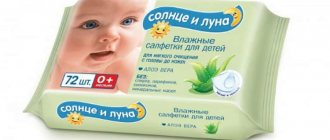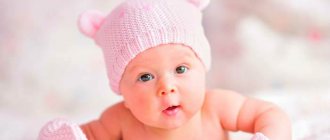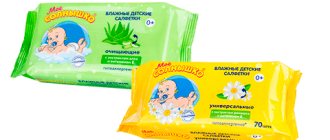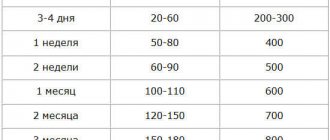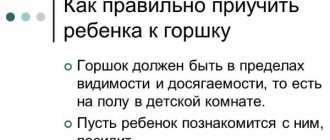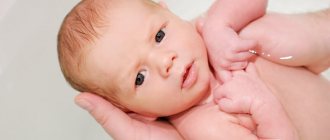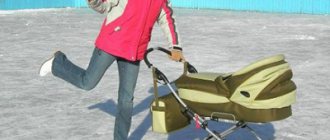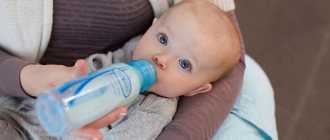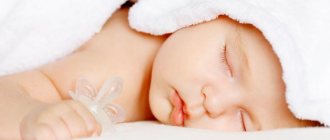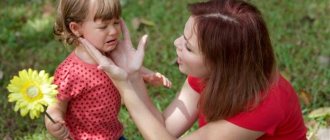During your pregnancy, you probably studied the issue of intimate hygiene for your unborn child. It seemed to you that you were going into childbirth completely savvy. But as soon as you found yourself outside the maternity hospital, all knowledge disappeared somewhere. Don't panic, this situation happens very often.
And, since you are reading these lines, let’s refresh your memory and figure out in detail how to properly wash a baby girl.
- 4.1. Washing algorithm
How to wash a girl under the tap
A particular issue that worries young mothers is doubt about the admissibility of washing the baby with ordinary tap water. Very often parents want to do this procedure only with boiled water.
But tap water is a completely suitable option; the main rule for washing newborns is running water. There is no point in washing the baby off the bowl, where germs again end up and further contaminate the baby’s body.
To wash the girl under the tap, you need to direct the stream of water to the pubis, trying not to hit the peri-umbilical area. The water will wash the genitals and flow between the legs.
Features of hygiene for chickenpox
It is a mistake to believe that washing children during chickenpox is contraindicated. According to pediatricians, doing this is not just desirable, but necessary, but subject to a number of basic rules.
List of rules:
- avoid contact of the child’s body with the washcloth;
- stop using cosmetics in favor of herbal decoctions and a weak solution of potassium permanganate (they have antiseptic properties and promote rapid healing of injured skin);
- bathe the child only if he does not have an elevated body temperature.
How often to wash a girl
The main thing in this matter is not to overdo it. Today's range of reusable diapers makes baby hygiene a breeze.
Typically, the diaper absorbs feces and keeps you reasonably comfortable and dry. Therefore, we provide general recommendations on the frequency of washing:
- After each diaper change, wash your baby only with running water without using any auxiliary products, such as soap, gels, foams.
- After defecation, be sure to use baby soap or gel.
- Evening bathing before bed with liquid baby soap or gel.
Caring for a boy's genitals
Now let's look at how to wash a newborn boy. This procedure also has its own characteristics.
In a boy, special attention should be paid to the head of the penis, which is covered by the foreskin. It is not recommended to pull off this delicate and delicate skin (at least until the child reaches one year of age)
At the same time, it is important to know that in boys, smegma can accumulate in the foreskin sac - white flakes that are formed from the secretion of the sebaceous glands
Smegma needs to be removed, but this should be done only once a day after evening bathing. It is not necessary to carry out this procedure every day, only as needed; You must act very carefully, without pressure, slightly moving the foreskin. To do this, it is recommended to moisten your thumb and index finger in boiled vegetable oil and gently push the skin apart with them.
A cotton pad should also be soaked in oil and blot the upper part of the boy’s genitals with it;
Know! It is not advisable to use a cotton swab for this case, since it may leave lint or pieces of cotton wool.
- At the end of the procedure, the foreskin must be released and the entire head of the penis should be lubricated with a drop of oil;
- No need to try to get further under the foreskin to clean out all the white plaque! As a result of the movement of the skin, these flakes themselves move closer to the edge, and then they can be easily removed.
When washing a boy, it is recommended to follow the following sequence:
- First, place the baby on your arm, belly down, and thoroughly wash the bottom;
- Turn the baby onto his back and place his penis and scrotum under the water.
You should not immediately put on a diaper for your boy after bathing. It is very useful to let the body “breathe”. It is advisable that the baby wear regular panties or rompers for the first half hour to an hour after washing.
By taking care of proper intimate hygiene of a newborn girl or boy, parents save their baby from serious problems that can negatively affect his future health.
- How to clean a newborn's nose?
- How to treat a newborn's navel?
- Water temperature for bathing a newborn
How to wash a newborn
The process of washing a newborn baby can be divided into two phases - before and after the navel heals. The first bathing procedures are slightly complicated by the presence of an umbilical wound. Later, after the umbilical remnant has healed and fallen off, it will be possible to wash the child with complete immersion in water, but first you need to be very careful. The general rules for washing your baby are as follows:
- The presence of a small baby bath, pre-rinsed with special baby products and washed well.
- The water temperature should be 37-38°C, the room temperature 25-26°C.
- It is not necessary to boil the water.
- If possible, in the first 2-3 days you can add a few crystals of potassium permanganate - potassium permanganate will perfectly disinfect water.
- You can add herbal decoctions to the water. Chamomile, string, oak bark, etc. are best suited.
- The bath should be two-thirds filled with water.
- First the legs are immersed, and then the whole baby to the middle of the chest.
- Using your hand, carefully pour water over the baby, stopping at the folds.
- The total bathing time for newborns in the first month is 5-10 minutes.
- At the end of the bathing procedure, the child is blotted with a previously prepared delicate film.
- For the first six months, it is advisable to bathe your baby daily.
- After six months, you can switch to swimming every other day.
The first days after birth
The first few days after the baby appears, a creamy white or milky coating may form on her labia, having a dense texture (no odor). These are the remains of the original lubricant (smegma).
Neonatologists recommend doing nothing about this plaque and waiting until it goes away on its own. But these recommendations apply only to those cases where there is very little lubricant, and it is slowly removed after carrying out hygienic measures.
If there is a lot of plaque, parents will have to remove it themselves. The fats contained in smegma begin to oxidize after 2-3 days and can cause serious inflammation.
To remove smegma, follow these steps:
- wash the baby (how to properly wash a newborn girl is described below);
- moisten a cotton swab or swab with boiled water;
- Gently move the stick over the plaque (do not rub!).
Original lubricant has a very dense texture, so it is impossible to get rid of it completely in one procedure. You should not rub the skin too hard to try to remove the remaining smegma - this can injure the genitals and lead to inflammation and infection.
Some mothers, on the advice of their grandmothers, use vegetable or Vaseline oil to wet a cotton swab. This is not recommended. The oil creates a film on the skin through which air does not penetrate, and when mixed with lubricant, it can cause irritation on the labia.
Is it possible to wash a girl
You can and should definitely wash the girl! Even the highest quality modern wet wipes cannot replace this natural process.
The main thing is to follow the general recommendations:
- The stream of water should be directed from the pubis to the tailbone.
- The water should be as close in temperature as possible to 35-37°C.
- Use only running water.
- The use of detergents, best of all liquid soap, not every time, but only after a “big” event and in the evening.
- Wash only the outer labia and under no circumstances go to the mucous areas.
- Use wet wipes only when absolutely necessary.
What products should I use for washing?
For the hygienic cleansing of the genitals of babies, many safe products are produced that do not contain dyes, artificial additives and components harmful to the skin.
Doctors' recommendations regarding what to wash a girl in her first year of life are the same: only baby soap or a special soft gel for washing babies. They should be used in cases where the child has had a bowel movement; in all other situations, running water is the best way to keep the baby’s genitals clean.
If the skin has inflammation or signs of irritation (rash, redness), you can use decoctions of anti-inflammatory herbs with a calming effect: chamomile, calendula, sage. They will help eliminate unpleasant symptoms and soften thin skin.
Decoctions of medicinal herbs can be added to water while bathing. If you don’t have the time or desire to prepare them yourself, you can buy ready-made formulations at the pharmacy, for example, herbs for bathing in the form of “Our Mother” decoction.
To wash girls, it is not allowed to use products intended for the intimate hygiene of adult women, as well as regular soap, as they disrupt the normal acidity level of the vagina and dry out the skin, destroying beneficial microflora.
How to wash a baby girl a month
Features of washing girls in the first month of life contain several important points:
- Your movements must be confident, despite the fact that sometimes it can be scary, so as not to harm the baby.
- Carefully direct the stream of water to avoid contact with the umbilical wound area.
- A newborn girl has a special white lubricant between her labia - smegma. This is a kind of barrier to protect against bacteria. Under no circumstances should it be washed. It will come out on its own after a constant process of washing.
- When washing, perform all movements only with your hands. Trim your nails, remove your rings, and wash your hands clean. Avoid excessive use of cotton swabs, pads, diaper corners, etc.
- After washing, simply blot the baby's perineum and entire body with a gentle film or towel.
Basic Rules
In the first 2 weeks of the baby’s life, you can only use boiled water for washing. Be sure to check her temperature before the procedure; it should not be higher than +37 °C. It is forbidden to wash a newborn girl in standing water, for example, in a basin. First use a teapot or watering can, and later you can wash the child under the tap. The baby's skin is very delicate, so you should avoid washing it with a washcloth. If you notice a white coating in the genital area, do not try to remove it. This is a natural barrier that prevents harmful bacteria from entering the vagina.
Use intimate hygiene products for children no more than 3 times a week. Despite manufacturers' assurances, these substances can be harmful to the skin. Do not use regular alkaline soap. Be careful not to let water get into your baby's vagina. In extreme cases, you can wipe the child's skin with a damp cloth without antiseptics or alcohol. After completing the water procedures, do not put on the diaper for several minutes so that the skin has time to breathe. Choose soft towels made from natural fabrics for your child. Refrain from growing long nails in the first period of a child's life: you can easily scratch the baby. There should also be no cuts, inflammations or ulcers on your hands.
It is important to be able to hold the baby correctly during the procedure. Place her on your left palm with her back so that the baby's head, neck and shoulders lie on your hand near the elbow
Use the fingers of your left hand to hold the baby's thigh, and wash it with your right hand. You can also bathe the girl with her back up. To do this, place her tummy on your palm, and place her head on the bend of your elbow. When cleaning, move your hand from the genitals toward the anus to reduce the risk of feces getting into the vagina.
How to wash a 3 year old girl
At about the age of 2-3 years, a girl should be taught to perform independent hygiene procedures. When washing, show your daughter the correct steps and ask her to do it herself in front of you. Tell me if something is wrong. You should also adhere to several rules:
- Washing should be a daily ritual. Even if we are not talking about a full bath, then we need to teach that she simply must wash herself.
- Use running water at room temperature.
- You need to wash from front to back so that bacteria from the anus do not get into the vagina.
- It is advisable to use liquid soap with a neutral pH level rather than bar soap. Liquid soap intended for children from birth is best.
- The girl should have a separate towel or wrap, just hers.
Reviews from doctors
Gortaeva N.V., pediatrician, family medical center in Solntsevo, Moscow
I would like to advise young mothers that it is better to get rid of vernix lubrication not with warm water, but with slightly heated oil. I recommend buying oil at a pharmacy.
Before using oil. Apply a drop to the inside of the baby's arm and wait 24 hours. If no redness occurs, which could indicate an allergy, the oil can be used.
Levshina N.V., gynecologist, Kutuzovsky diagnostic and treatment center, Moscow
Problems with diaper rash and prickly heat can be solved in the early stages. It will be enough to wash the child without soap under warm running water and do this more often than minimal care requires.
If it is hot outside, it is advisable to change the diaper at least once every 1.5-2 hours. Also, the child should not be in it all the time. A good way to prevent diaper rash is to take daily air baths for 20-30 minutes 3 times a day.
Washing a month old baby girl
The general hygiene rules for girls under 1 month of age were described above, but I would like to mention some more important nuances:
- wash the baby every time you change the diaper;
- Do not use any synthetic creams or powders. They will only be needed for diaper rash; a healthy baby should not avoid these products and wet wipes either - they contain fragrances that can cause an allergic reaction on the baby’s delicate skin;
- When bathing, use only baby soap. Products for adults act quite aggressively on the baby’s skin; also keep an eye on the mammary glands of a one-month-old girl, since due to the increased amount of estrogen in the mother, the baby may release blood or colostrum from the papillae, and the breasts may swell. Gently rinse the girl's breasts with each wash.
What should you remember when washing a girl?
For a mother who has a daughter, it is important to remember that due to the anatomical structure of the baby, the genital area is very sensitive to external stimuli. When maintaining body hygiene for a newborn girl, water procedures should not be neglected; the baby should be washed regularly, thoroughly, adhering to certain rules
At the same time, you need to know that beneficial bacteria that are found on the skin and mucous membrane are necessary to maintain a healthy environment. To prevent beneficial microflora from being washed out excessively, experts advise washing the baby with soap no more than three times a week.
How to properly wash your baby
When washing a child, you need to take into account the peculiarities of this ritual for girls and boys. Girls are washed in the direction from gears backwards, and boys, on the contrary, from back to front. The water should be running and at room temperature. Soap should not be used during every washing procedure, but only after defecation.
What are the dangers of poor intimate hygiene?
Insufficient hygiene of girls can lead to infectious diseases and inflammatory processes. Vaginitis is most common in young girls. Vaginal dysbiosis is another pathology that occurs as a result of disruption of the vaginal microflora and the spread of pathogenic microorganisms to the mucous membranes of the genital organs.
Proper intimate care in infancy is a guarantee of the future health of girls. Compliance with the basic rules and recommendations of doctors will help to avoid typical mistakes of young parents and prevent the development of dangerous infectious diseases.
Why such control in this matter?
Like all parents, you probably want to raise a healthy daughter. That is why it is so important to carefully care for the genitals in the first months of her life. After all, they are not yet protected in a newborn, and the hymen is at the stage of formation. Therefore, the possibility of pathogenic microorganisms entering the vagina is quite high. This risk is increased by:
- feces that are not completely absorbed into the diaper;
- low-quality children's cosmetics.
Such factors can provoke inflammation, which will adversely affect her health. Over time, the mucous membranes will be “populated” by beneficial microflora, but for now it is simply necessary to properly wash the newborn, since this is the key to her gynecological health and the preservation of reproductive function in the future. You can find out how a baby develops at the beginning of his life’s journey from the article: “Development of a newborn.”
